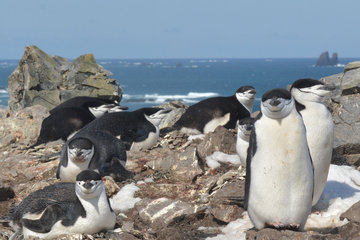Citizens reveal that pairs of rufous horneros have specific preferences when it comes to nest building
The breeding pair jointly builds a complex nest with asymmetric architecture
Pairs of the rufous horneros collectively build a remarkable mud nest. This domed nest has a puzzling asymmetric architecture: the entrance can be positioned on the right or left - and this usually repeats for the new nests the pair builds each year. Scientists from the Max Planck Institute for Ornithology (now MPI for Biological Intelligence, i.f.), found that the bilateral asymmetry of the nest does not occur by chance. With the help of more than 1,200 citizen scientists, they collected nest data across the entire range of the rufous hornero in South America, comparing more than 12,600 nests. Environmental factors did not explain the position of the entrance. Instead, the researchers suspect a genetic basis.

The rufous hornero (Furnarius rufus, herafter termed ‘hornero’) lives in South America and builds a rock-hard, spherical nest from clay, mud, plant parts or dung, which is reminiscent of an adobe oven. This is why it is also called ‘ovenbird’, or ‘hornero’ in Spanish - meaning baker or the person that works at the oven. They form lifelong pairs that defend their territory year-round.
The sophisticated nest is built on trees, but also on telephone poles or house gables, and is bilaterally asymmetrical: thus, the entrance can be either on the left or right side of the dome. Bilateral asymmetry is also found in the architecture of other animals, for example, in ant nests, but it has never been studied on a collectively built structure of a vertebrate. In the case of the hornero’s clay nest, both parent birds are equally involved in building the nest, each transporting about 1,500 portions of clay and plant fibers.

Nicolas M. Adreani, Mihai Valcu and Lucía Mentesana from the Max Planck Institute for Ornithology (now MPI for Biological Intelligence, in foundation), wanted to find out whether it is a coincidence on which side the nest entrance is located. To do this, they designed a smartphone app and encouraged the participation of over 1,200 citizens to collect photos and data on nest architecture over 1 year. The data provide information on both the asymmetry of the entrance (left or right) and the characteristics of the nest site (nest height, cover, substrate, entrance orientation, and urbanization context).

"At the population level, we found 12% more nests with a right entrance than with a left entrance," says Nicolas Adreani, lead author of the study. Here, the position of the nest entrance is not only non-random in the population, but highly repeatable among different hornero’s pairs. It is therefore very likely that a pair always builds a nest with the same asymmetrical architecture, this is, the entrance always on the same side. Although a nest exists for several years, it is not used seasonally. Thus, several nests of a pair from successive years could usually be recorded in one area and the nest asymmetry of one and the same pair could be measured repeatedly.
Different environmental variables such as temperature, precipitation, altitude, or nest site characteristics did not explain the position of the entrance at the nest. "We were able to analyze data from 12,606 nests across the species' range, about 4.8 million square kilometers including 5 countries: Argentina, Uruguay, Paraguay, Bolivia and Brazil" says Lucía Mentesana, the study's principal investigator. The lack of influence of environmental factors on nest asymmetry and the high repeatability at the pair level suggests to the scientists that an individual can only form an asymmetric phenotype. "We think that the remarkable repeatability of bilateral nest architecture has a genetic basis," says Lucía Mentesana. Whether the asymmetry of the nest depends on both partners or only one needs to be clarified by further studies.
The citizen science aspect of the project has not only been extremely exciting for the scientists, but has had a great impact both in the community and on them: "There has been a lot of positive feedback," says Nicolas Adreani. "Especially from people who live in cities. They even told us that they went outside more and rediscovered nature thanks to the nest search." The involvement of citizen scientists was therefore a benefit for the participants and the researchers alike.














